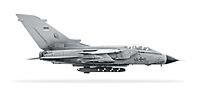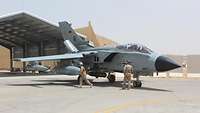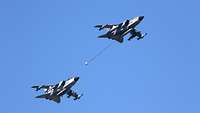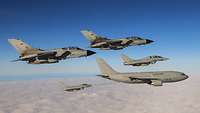




The PA-200 Tornado is a tri-nationally developed, all-weather, two-seat combat aircraft that was introduced into the armed forces by Germany, the United Kingdom and Italy from 1980 onwards. Germany, Italy and Saudi Arabia use the combat aircraft in different roles. Delivery of the first PA-200 Tornados to the Bundeswehr began in 1981 and was completed in 1992 with the handover of the last PA-200 Tornado ECRElectronic Combat Reconnaissance (Electronic Combat and Reconnaissance) aircraft. A total of 357 multi-role combat aircraft was delivered to the German Air Force and the German Navy.
As a result of the changed security situation since 1989 and due to the fact that the Eurofighter will also cover the air attack capability spectrum in the future, the German Air Force has reduced the number of its Tornados to 85 weapon systems. The PA-200 Tornado aircraft remaining in the Air Force will be subject to a service life extension and comprehensive modernization programs in order to continue to prevail in future scenarios.
The terrain following radar (TFR) of the PA-200 Tornado allows extreme low-level flight adapted to the terrain profile – at an altitude of 60 meters in almost any weather condition. The autopilot takes over control. In pure visual flight and with manual control, the flight altitude can be reduced further to 30 meters.

A Eurofighter of 31 Tactical Air Wing and a Tornado IDSInterdiction Strike (Interdiction Strike) of 33 Tactical Air Wing flying together in an operational formation
Bundeswehr/Stefan PetersenDue to its advanced and highly sophisticated flight control, navigation, mission and weapon computer avionics and a very effective self-protection system, the PA-200 Tornado achieves a high accuracy with a high lethality, especially under threat.
The operational and training units of the Air Force have a total of 85 PA-200 Tornado aircraft at their disposal; the entire fleet comprises 93 Tornados. It consists of two versions of the aircraft: the Tornado IDSInterdiction Strike (Interdiction Strike) fighter bomber and the Tornado ECRElectronic Combat Reconnaissance (Electronic Combat and Reconnaissance). All Tornados are equipped with the Airborne Reconnaissance Pod II are thus also capable of optical and infrared reconnaissance (RECCEReconnaissance ) (Reconnaissance).
The IDSInterdiction Strike (Interdiction Strike) version
The Tornado IDSInterdiction Strike (Interdiction Strike) is the basic version of the fighter bomber. It is capable of supporting ground forces from the air (also in the form of close air support), battlefield interdiction (preventing the arrival of new ground forces) and air attacks on enemy facilities and positions. The IDSInterdiction Strike (Interdiction Strike) Tornado is fitted with extensive self-defense assets and equipment.

A Tornado IDSInterdiction Strike combat aircraft lands at the Air Base in Al-Asrak, Jordan, during Mission Counter Daesh
Bundeswehr/PAO Counter DaeshThe ECRElectronic Combat Reconnaissance (Electronic Combat Reconnaissance) version
The ECRElectronic Combat Reconnaissance (Electronic Combat and Reconnaissance) version was developed from the IDSInterdiction Strike (Interdiction Strike) version at the request of the German Air Force. The ECRElectronic Combat Reconnaissance (Electronic Combat and Reconnaissance) is used for the location, identification and, if necessary, engagement of radar systems and radar-controlled air defense systems. The emitter location system (ELS) locates and identifies radars. An enemy radar can then be attacked with high-speed antiradiation missiles (HARM).
The RecceLite version
Since 2009, the German Air Force uses the RecceLite digital reconnaissance system. It significantly improves the quality of the reconnaissance results and increases the analysis options. In addition, it allows real-time in-flight transmission of reconnaissance results to the ground station. RecceLite has the capability to generate high-resolution digital images by day and night using infrared and optical sensors at low and medium altitudes, thus significantly reducing the threat level for the Tornado crews. The optical and infrared reconnaissance sensors are carried in a pod under the aircraft fuselage.
| LENGTH | 17,23 m |
|---|---|
| HEIGHT | 5,95 m |
| WINGSPAN AT 25° SWEEP | 13,91 m |
| WINGSPAN AT 45° SWEEP | 11,58 m |
| WINGSPAN AT 67° SWEEP | 8,56 m |
| WING AREA AT 25° SWEEP | 31 m² |
| EMPTY WEIGHT | 14 t |
| MAX. TAKEOFF WEIGHT | 28,5 t |
| ENGINE | 2x Turbo-Union RB199-34R |
| MAX. DRY THRUST | 41.000 N |
| REHEAT THRUST | 69.000 N |
| SPEED (AT LOW-LEVEL FLIGHT) | bis Mach 1,3 |
| IDSInterdiction Strike (Interdiction Strike) version | |
| INTERNAL GUN | BK 27mm Mauser |
| Air-to-Air | AIM-9L Sidewinder, IRIS-TInfra-Red Imaging System–Tail/Thrust Vector-Controlled (InfraInfrastruktur-Red Imaging System – Tail/Thrust Vector controlled) |
| Air-to-Ground | Ballistic bombs (high-drag and low-drag) MK-82, MATRA laser-guided bombs, laser designator pod LITENING III GBUGuided Bomb Unit (Guided Bomb Unit) -24, GBUGuided Bomb Unit (Guided Bomb Unit) -54, AGM-88B HARM, Taurus KEPD 350 |
| ECRElectronic Combat Reconnaissance (Electronic Combat and Reconnaissance) version | |
| Air-to-Air | AIM-9L Sidewinder, IRIS-TInfra-Red Imaging System–Tail/Thrust Vector-Controlled (InfraInfrastruktur-Red Imaging System – Tail/Thrust Vector controlled) |
| Air-to-Ground | Ballistic bombs laser-guided bombs, laser designator pod |
| Recce-Version | |
| INTERNAL GUN | BK 27mm Mauser |
| Air-to-Air | AIM-9L Sidewinder, IRIS-TInfra-Red Imaging System–Tail/Thrust Vector-Controlled (InfraInfrastruktur-Red Imaging System – Tail/Thrust Vector controlled) |
| Air-to-Ground | Airborne Reconnaissance Pod II (ARP II) |

An ECRElectronic Combat Reconnaissance (Electronic Combat and Reconnaissance) Tornado and an IDSInterdiction Strike (Interdiction Strike) Tornado with RecceLite pod of 51 Tactical Air Wing Immelmann in Jagel, Germany
Bundeswehr/Stefan Petersen
A weapon system officer of 51 Tactical Air Wing Immelmann is sitting in a Tornado combat aircraft in Jagel, Germany
Bundeswehr/Oliver Pieper
Three Tornado combat aircraft are ready to take off from Nellis Air Force Base near Las Vegas during the multinational Green Flag West 2018 exercise
Bundeswehr/Francis Hildemann
Two PA-200 Tornados demonstrate air refueling in the air above Jagel (Schleswig-Holstein)
Bundeswehr/Ralf Nöhmer
A Tornado jet flies with special painting to mark the 25th anniversary of 51 Tactical Air Wing Immelmann during the Spotters’ Day before the Bundeswehr Day 2019 in Jagel, Germany
Bundeswehr/Carsten Vennemann
A look deep into the engines of a Tornado jet at the air base in Al Azraq in Jordan during the Counter Daesh mission
Bundeswehr/Jürgen Sickmann
A pilot is taxiing to the runway with his PA-200 Tornado in Al Azraq (Jordan)
Bundeswehr/Sebastian Wilke
Eurofighters of 31 Tactical Air Wing and PA-200 Tornados of 33 Tactical Air Wing flying together with an Airbus A310 MRTTMulti Role Tanker Transport (Multi Role Tanker Transport) refueling aircraft at the Air Force base in Laage, Germany
Bundeswehr/Stefan Petersen